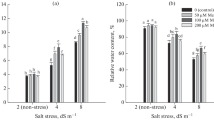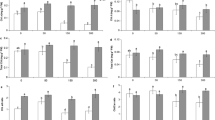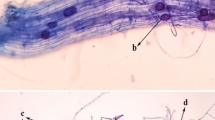Abstract
German chamomile is an important essential oil plant that has adaptability to a wide range of climates and soils. Methyl jasmonate (MJ) is a plant growth regulator that involves in many morphological and physiological processes and has a role in defense systems of plants under stress conditions. Here, a pot-culture study was undertaken to investigate the possible role of MJ treatment on the growth and different chemical constituents of German chamomile plants subjected to salinity stress. The aim was to determine whether MJ could protect chamomile production against salinity and whether this protection was associated with regulation of antioxidant enzymes. Our results show that treatment of chamomile plants with 75 µM MJ leads to increases in plant growth in terms of flower, straw and root dry weights. The photosynthetic rate concomitantly with membrane stability index, potassium content, as well as free proline content was markedly increased. In addition, the quercetin content was increased significantly in flowers. Moreover, the application of the investigated 75 μM MJ significantly improved enzyme activities in terms of catalase, peroxidase and ascorbate peroxidase activities. Sodium and proline contents were also measured and finally, effects of MJ and salinity interactions on all characteristics as well as relationship of antioxidant enzymes activity with proline content were investigated. As a conclusion, treating chamomile plants with 75 μM MJ could alleviate the harmful effects of salinity stress.






Similar content being viewed by others
Abbreviations
- APX:
-
Ascorbate peroxidase
- CAT:
-
Catalase
- FDW:
-
Flower dry weight
- MJ:
-
Methyl jasmonate
- PC:
-
Proline content
- POD:
-
Peroxidase
References
Amjad M, Akhtar J, Anwar-ul-Haq M, Yang A, Akhtar SC, Jacobsen E (2014) Integrating role of ethylene and ABA in tomato plants adaptation to salt stress. Sci Hortic 172:109–116
Ashraf M (2009) Biotechnological approach of improving plant salt tolerance using antioxidants as markers. Biotechnol Adv 27:84–93
Ashraf M, Harris PJC (2013) Photosynthesis under stressful environments: an overview. Photosynthetica 51:163–190
Baczek-Kwinta R, Adamska A, Seidler-Lozykowska K, Tokarz K (2010) Does the rate of German chamomile growth and development influence the response of plants to soil drought? Biologia 65:837–842
Bastam N, Baninasab B, Ghobadi C (2013) Improving salt tolerance by exogenous application of salicylic acid in seedlings of pistachio. Plant Growth Regul 69:275–284
Bates L, Waldern R, Teare I (1973) Rapid determination of free proline for water stress studies. Plant Soil 39:205–207
Bradford M (1979) A rapid and sensitive method for the quantitation of microgram quantities of protein utilizing the principle of protein–dye binding. Anal Biochem 72:248–254
Chance B, Maehly A (1995) Assay of catalase and peroxidase. Methods Enzymol 2:764–775
Cheong JJ, Choi YD (2003) Methyl jasmonate as a vital substance in plants. Trends Genet 19:409–413
Debez A, Saadaoui D, Ramani B, Ouerghi Z, Koyro H, Huchzermeye B, Abdelly C (2006) Leaf H+-ATPase activity and photosynthetic capacity of Cakile maritima under increasing salinity. Environ Exp Bot 57:285–295
Farooq M, Wahid A, Kobayashi N, Fujita D, Basra SMA (2009) Plant drought stress: effects, mechanisms and management. Agron Sustain Dev 29:185–212
Fedina I, Benderliev K (2000) Response of Secendesmus incrassatulus to salinity stress as affected by methyl jasmonate. Biol Plant 43:625–627
Gao X, Wang X, Lu Y, Zhang L, Shen Y, Liang Z, Zhang D (2004) Jasmonic acid is involved in the water–stress-induced betaine accumulation in pear leaves. Plant Cell Environ 27:497–507
Golldack D, Li C, Mohan H, Probst N (2014) Tolerance to drought and salt stress in plants: unraveling the signaling networks. Front Plant Sci 5:1–10
Horie T, Karahara I, Katsuhara M (2012) Salinity tolerance mechanisms in glycophytes: an overview with the central focus on rice plants. Rice 5:1–18
Iqbal N, Umar S, Khan NA, Khan MIR (2014) A new perspective of phytohormones in salinity tolerance: regulation of proline metabolism. Environ Exp Bot 100:34–42
Ismail A, Riemann M, Nick P (2012) The jasmonate pathway mediates salt tolerance in grapevines. J Exp Bot 63:2127–2139
Kang DJ, Seo YJ, Lee JD, Ishii R, Kim KU, Shin DH, Park SK, Jang SW, Lee IJ (2005) Jasmonic acid differentially affects growth, ion uptake and abscisic acid concentration in salt-tolerant and salt-sensitive rice cultivars. J Agron Crop Sci 191:273–282
Little RC, Milliken GA, Stroup WW, Wolfinger RD (1996) SAS system for mixed models. SAS Inst, Cary
Lu S, Su W, Li H, Guo Z (2009) Abscisic acid improves drought tolerance of triploid bermudagrass and involves H2O2- and NO-induced antioxidant enzyme activities. Plant Physiol Biochem 47:132–138
Moran JF, Becana M, Ittrbe-Ormaetxe I, Frechilla S, Klucas RV, Aparicio-Tejo P (1994) Drought induces oxidative stress in pea plants. Planta 194:346–352
Mukkun L, Singh Z (2009) Methyl jasmonate plays a role in fruit ripening of ‘Pajaro’ strawberry through stimulation of ethylene biosynthesis. Hortic Sci 123:5–10
Munns R, Tester M (2008) Mechanisms of salinity tolerance. Ann Rev Plant Physiol 59:651–681
Murillo-Amador B, Yamada S, Yamaguchi T, Rueda-Puente E, Avila-Serrano N, Garcia-Hernandez JL, Lopez-Aguilar R, Troyo-Dieguez E, Nieto-Garibay A (2007) Influence of calcium silicate on growth, physiological parameters and mineral nutrition in two legume species under salt stress. J Agron Crop Sci 193:413–421
Mustafa Z, Pervez MA, Ayyub CM, Matloob A, Khaliq A, Hussain S, Ihsan MZ, Butt M (2014) Morpho-physiological characterization of chilli genotypes under NaCl salinity. Soil Environ 33:133–141
Nakano Y, Asada K (1981) Hydrogen peroxide is scavenged by ascorbate-specific peroxidase in spinach chloroplasts. Plant Cell Physiol 22:867–880
Nazar R, Iqbal N, Syeed S, Khan NA (2011) Salicylic acid alleviates decreases in photosynthesis under salt stress by enhancing nitrogen and sulfur assimilation and antioxidant metabolism differentially in two mung bean cultivars. J Plant Physiol 168:807–815
Noctor G, Mhamdi A, Foyer CH (2014) The roles of reactive oxygen metabolism in drought: not so cut and dried. Plant Physiol 164:1636–1648
Peleg Z, Blumwald E (2011) Hormone balance and abiotic stress tolerance in crop plants. Curr Opin Plant Biol 14:290–295
Poonam S, Kaur H, Geetika S (2013) Effect of jasmonic acid on photosynthetic pigments and stress markers in Cajanus cajan (L.) Millsp. Seedlings under copper stress. Am J Plant Sci 4:817–823
Rhoades JD (1990) Determining soil salinity from measurements of electrical conductivity. Commun Soil Sci Plant Anal 21:1887–1926
Sai-Kachout S, Hamza KJ, Bouraoui NK, Leclerc JC, Ouerghi Z (2013) Salt-induced changes in antioxidative enzyme activities in shoot tissues of two atriplex varieties. Not Bot Horti Agrobo 41:115–121
Sairam RK, Srivastava GC (2002) Changes in antioxidant activity in sub-cellular fractions of tolerant and susceptible wheat genotypes in response to long term salt stress. Plant Sci 162:897–904
Saud S, Chen Y, Baowen L, Fahad S, Arooj S (2013) The different impact on the growth of cool season turf grass under the various conditions on salinity and drought stress. Int J Agric Sci Res 3:77–84
Sharma I, Ching E, Saini S, Bhardwaj R, Pati PK (2013) Exogenous application of brassinosteroid offers tolerance to salinity by altering stress responses in rice variety Pusa Basmati-1. Plant Physiol Biochem 69:17–26
Soares LAL, Bassani VL, González Ortega G, Petrovick PR (2003) Total flavonoid determination for the quality control of aqueous extractives from Phyllanthus niruri L. Lat Am J Pharm 22:203–207
Tardieu F, Tuberosa R (2010) Dissection and modeling of abiotic stress tolerance in plants. Curr Opin Plant Biol 13:206–212
Tariq A, Masroor M, Khan A, Mohd I, Naeem M, Moinuddin I, Nadeem H (2011) Methyl jasmonate counteracts boron toxicity by preventing oxidative stress and regulating antioxidant enzyme activities and artemisinin biosynthesis in Artemisia annua L. Protoplasma 248:601–612
Walia H, Wilson C, Wahid A, Condamine P, Cui X, Close TJ (2006) Expression analysis of barley (Hordeum vulgare L.) during salinity stress. Funct Integr Genomics 6:143–156
Walia H, Wilson C, Condamine P, Liu X, Ismoil AM, Close TJ (2007) Large-scale expression profiling and physiological characterization of jasmonic acid-mediated adaptation of barley to salinity stress. Plant Cell Environ 30:410–421
Wang W, Vinocur B, Altman A (2003) Plant responses to drought, salinity and extreme temperatures: towards genetic engineering for stress tolerance. Planta 218:1–14
Wang J, Qian J, Yao L, Lu Y (2015) Enhanced production of flavonoids by methyl jasmonate elicitation in cell suspension culture of Hypericum perforatum. Bioresour Bioprocess 2:1–9
Wasternack C (2014) Action of jasmonates in plant stress responses and development—applied aspects. Biotechnol Adv 32:31–39
Yong Z, Hao-Ru T, Ya L (2008) Variation in antioxidant enzyme activities of two strawberry cultivars with short-term low temperature stress. World J Agric Sci 4:458–462
Yoon JY, Hamayun M, Lee SK, Lee IJ (2009) Methyl jasmonate alleviated salinity stress in soybean. J Crop Sci Biotechnol 12:63–68
Zhang J, Mu C (2009) Effects of saline and alkaline stresses on the germination growth, photosynthesis, ionic balance and anti-oxidant system in an alkali-tolerant leguminous forage Lathyrus quinquenervius. Soil Sci Plant Nut 55:685–697
Acknowledgments
This work was financed by the Ministry of Science, Research and Technology of Iran. Authors are very grateful for the help and technical assistance of Afshin Tavakoli, Mohammad Reza Azimi and Esmail Zangani.
Author information
Authors and Affiliations
Corresponding author
Ethics declarations
Conflict of interest
The authors declare that they have no conflict of interest.
Additional information
Communicated by J. Kovacik.
Rights and permissions
About this article
Cite this article
Salimi, F., Shekari, F. & Hamzei, J. Methyl jasmonate improves salinity resistance in German chamomile (Matricaria chamomilla L.) by increasing activity of antioxidant enzymes. Acta Physiol Plant 38, 1 (2016). https://doi.org/10.1007/s11738-015-2023-4
Received:
Revised:
Accepted:
Published:
DOI: https://doi.org/10.1007/s11738-015-2023-4




